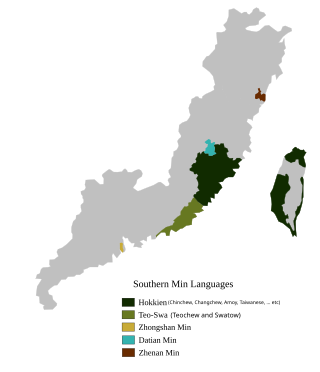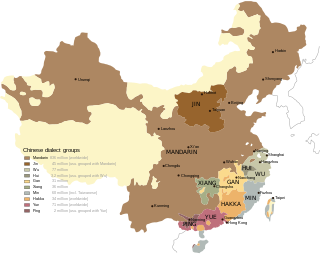
Chinese is a group of languages spoken natively by the ethnic Han Chinese majority and many minority ethnic groups in China. Approximately 1.35 billion people, or 17% of the global population, speak a variety of Chinese as their first language.

Mandarin is a group of Chinese language dialects that are natively spoken across most of northern and southwestern China. The group includes the Beijing dialect, the basis of the phonology of Standard Chinese, the official language of China. Because Mandarin originated in North China and most Mandarin dialects are found in the north, the group is sometimes referred to as Northern Chinese. Many varieties of Mandarin, such as those of the Southwest and the Lower Yangtze, are not mutually intelligible with the standard language. Nevertheless, Mandarin as a group is often placed first in lists of languages by number of native speakers.

Standard Chinese is a modern standard form of Mandarin Chinese that was first codified during the republican era (1912‒1949). It is designated as the official language of mainland China and a major language in the United Nations, Singapore, and Taiwan. It is largely based on the Beijing dialect. Standard Chinese is a pluricentric language with local standards in mainland China, Taiwan and Singapore that mainly differ in their lexicon. Hong Kong written Chinese, used for formal written communication in Hong Kong and Macau, is a form of Standard Chinese that is read aloud with the Cantonese reading of characters.

Yue is a branch of the Sinitic languages primarily spoken in Southern China, particularly in the provinces of Guangdong and Guangxi.

Min is a broad group of Sinitic languages with about 70 million native speakers. These languages are spoken in Fujian province as well as by the descendants of Min-speaking colonists on the Leizhou Peninsula and Hainan and by the assimilated natives of Chaoshan, parts of Zhongshan, three counties in southern Wenzhou, the Zhoushan archipelago, Taiwan and scattered in pockets or sporadically across Hong Kong, Macau, and several countries in Southeast Asia, particularly Singapore, Malaysia, the Philippines, Indonesia, Thailand, Myanmar, Cambodia, Vietnam, Brunei. The name is derived from the Min River in Fujian, which is also the abbreviated name of Fujian Province. Min varieties are not mutually intelligible with one another nor with any other variety of Chinese.

Southern Min, Minnan or Banlam, is a group of linguistically similar and historically related Chinese languages that form a branch of Min Chinese spoken in Fujian, most of Taiwan, Eastern Guangdong, Hainan, and Southern Zhejiang. Southern Min dialects are also spoken by descendants of emigrants from these areas in diaspora, most notably in Southeast Asia, such as Singapore, Malaysia, the Philippines, Indonesia, Brunei, Southern Thailand, Myanmar, Cambodia, Southern and Central Vietnam, San Francisco, Los Angeles and New York City. Minnan is the most widely-spoken branch of Min, with approximately 48 million speakers as of 2017–2018.

There are hundreds of local Chinese language varieties forming a branch of the Sino-Tibetan language family, many of which are not mutually intelligible. Variation is particularly strong in the more mountainous southeast part of mainland China. The varieties are typically classified into several groups: Mandarin, Wu, Min, Xiang, Gan, Jin, Hakka and Yue, though some varieties remain unclassified. These groups are neither clades nor individual languages defined by mutual intelligibility, but reflect common phonological developments from Middle Chinese.
Taishanese, alternatively romanized in Cantonese as Toishanese or Toisanese, in local dialect as Hoisanese or Hoisan-wa, is a Yue Chinese dialect native to Taishan, Guangdong. Although related, Taishanese has little mutual intelligibility with Cantonese. Taishanese is also spoken throughout Sze Yup, located on the western fringe of the Pearl River Delta in Guangdong China. In the late 19th century and early 20th century, most of the Chinese emigration to North America originated from Sze Yup. Thus, up to the mid-20th century, Taishanese was the dominant variety of the Chinese language spoken in Chinatowns in Canada and the United States. It was formerly the lingua franca of the overseas Chinese residing in the United States.
Cantonese is the traditional prestige variety of Yue Chinese, a Sinitic branch of the Sino-Tibetan languages originating from the city of Guangzhou and its surrounding Pearl River Delta, with over 82.4 million native speakers.

Teochew, also known as Teo-Swa, is a Southern Min language spoken by the Teochew people in the Chaoshan region of eastern Guangdong and by their diaspora around the world. It is sometimes referred to as Chiuchow, its Cantonese rendering, due to English romanization by colonial officials and explorers. It is closely related to Hokkien, as it shares some cognates and phonology with Hokkien.

Written Cantonese is the most complete written form of a Chinese language after that for Mandarin Chinese and Classical Chinese. Written Chinese was the main literary language of China until the 19th century. Written vernacular Chinese first appeared in the 17th century, and a written form of Mandarin became standard throughout China in the early 20th century. Cantonese is a common language in places like Hong Kong and Macau. While the Mandarin form can to some extent be read and spoken word for word in other Chinese varieties, its intelligibility to non-Mandarin speakers is poor to incomprehensible because of differences in idioms, grammar and usage. Modern Cantonese speakers have therefore developed new characters for words that do not exist and have retained others that have been lost in standard Chinese.

The Hoklo people are a Han Chinese subgroup who speak Hokkien, a Southern Min language, or trace their ancestry to southeastern Fujian in China, and known by various related terms such as Banlam people, Minnan people, or more commonly in Southeast Asia as the Hokkien people. The Hokkien people are found in significant numbers in mainland China, Taiwan, Singapore, Malaysia, Philippines, Indonesia, Brunei, Myanmar, the United States, Hong Kong, and Macau. The Hokkien people have a distinct culture and architecture, including Hokkien shrines and temples with tilted sharp eaves, high and slanted top roofs, and finely detailed decorative inlays of wood and porcelain. The Hokkien language, which includes Taiwanese Hokkien, is the mainstream Southern Min, which is partially mutually intelligible to the Teochew language, Hainanese, Leizhou Min, and Haklau Min.

Pinghua refers to various Sinitic language varieties spoken mainly in parts of Guangxi, with some speakers in Hunan. Pinghua is a trade language in some areas of Guangxi, spoken as a second language by speakers of Zhuang languages. Some speakers are officially classified as Zhuang, and many are genetically distinct from most other Han Chinese. The northern subgroup is centered on Guilin and the southern subgroup around Nanning. The Southern dialect has several notable features such as having four distinct checked tones, and using various loanwords from the Zhuang languages, such as the final particle wei for imperative sentences.
The Han Chinese people can be defined into subgroups based on linguistic, cultural, ethnic, genetic, and regional features. The terminology used in Mandarin to describe the groups is: "minxi", used in mainland China or "zuqun", used in Taiwan. No Han subgroup is recognized as one of People's Republic of China's 56 official ethnic groups, in Taiwan only three subgroups, Hoklo, Hakka and Waishengren are recognized.

The Sinitic languages, often synonymous with the Chinese languages, are a group of East Asian analytic languages that constitute a major branch of the Sino-Tibetan language family. It is frequently proposed that there is a primary split between the Sinitic languages and the rest of the family. This view is rejected by a number of researchers but has found phylogenetic support among others. The Macro-Bai languages, whose classification is difficult, may be an offshoot of Old Chinese and thus Sinitic; otherwise Sinitic is defined only by the many varieties of Chinese unified by a shared historical background, and usage of the term "Sinitic" may reflect the linguistic view that Chinese constitutes a family of distinct languages, rather than variants of a single language.

The languages of Taiwan consist of several varieties of languages under the families of Austronesian languages and Sino-Tibetan languages. The Formosan languages, a geographically designated branch of Austronesian languages, have been spoken by the Taiwanese indigenous peoples for thousands of years. Owing to the wide internal variety of the Formosan languages, research on historical linguistics recognizes Taiwan as the Urheimat (homeland) of the whole Austronesian languages family. In the last 400 years, several waves of Han emigrations brought several different Sinitic languages into Taiwan. These languages include Taiwanese Hokkien, Hakka, and Mandarin, which have become the major languages spoken in present-day Taiwan.
Colloquial Singaporean Mandarin, commonly known as Singdarin or Singnese, is a Mandarin dialect native and unique to Singapore similar to its English-based counterpart Singlish. It is based on Mandarin but has a large amount of English and Malay in its vocabulary. There are also words from other Chinese languages such as Cantonese, Hokkien and Teochew as well as Tamil. While Singdarin grammar is largely identical to Standard Mandarin, there are significant divergences and differences especially in its pronunciation and vocabulary.
The usage of Chinese by the Chinese diaspora and their descendants has been determined by a large number of factors, including their ancestry, their migrant ancestors' "regime of origin", assimilation through generational changes, and official policies of their country of residence. The general trend is that more established Chinese populations in the Western world and in many regions of Asia have Cantonese as either the dominant variety or as a common community vernacular, while Mandarin is much more prevalent among new arrivals, making it increasingly common in many Chinatowns, though still not dominant.
Shu-mei Shih is a Korean-born Taiwanese American scholar and literary theorist. She is a Professor of Comparative Literature, Asian Languages and Cultures, and Asian American Studies at University of California, Los Angeles and was the president of the American Comparative Literature Association from 2021 to 2022. In 2018, she was also appointed as Honorary Chair Professor of Taiwan Languages, Literature and Culture at National Taiwan Normal University and is the current director of the UCLA-NTNU Taiwan Studies Initiative of the UCLA Asia Pacific Center.














